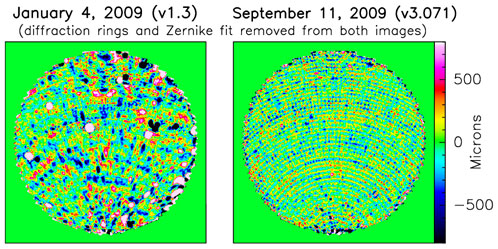September 2009 holography maps of the latest surface model for the Green Bank Telescope’s (GBT) active surface show that the surface accuracy of the central 60 meters of the 100-meter primary dish is now about 200 microns rms. The surface accuracy of the dish as a whole still varies due to thermal deformation on large scales, but it reaches values as low as 250-275 microns rms during stable thermal conditions.

Preliminary aperture efficiency measurements at 43 GHz yield values of 55-60% at most elevations, confirming the new surface statistics. As a result, we expect the high frequency performance for the upcoming observing season to be measurably better than last season. These improvements are the result of an iterative set of holography maps, surface adjustments, and efficiency measurements.
Using high-resolution 11.7 GHz holography maps, NRAO scientists and engineers have been able to identify the individual surface panel actuators that were out of adjustment, in which direction (+/-), and by what amount. In addition, during the summer maintenance period, several defective actuators were repaired, and several of the surface panel corners were re-set manually. For this most recent map, all of the GBT’s 2,209 surface panel actuators were in operation, a credit to the diligence and hard work of the GBT technicians.
The GBT has been operating regularly at 90 GHz since fall 2007 with the MUSTANG bolometer array. Continual improvements in both the MUSTANG array and the GBT high frequency performance have improved the measured aperture efficiency at 90 GHz by more than a factor of 2 (as of May 2009), and new measurements will be made soon. In addition to the improvements in small-scale errors from the holography maps, Out-Of-Focus (OOF) holography can be used by MUSTANG, Q-Band, and Ka-Band observers to measure and remove the large-scale deformations caused by surface heating and structural deformations during daytime and evening observations. Combined with additional instrumentation now installed on the structure and the digital servo control system under development, the GBT is well on its way to achieving its 3 mm performance goals.